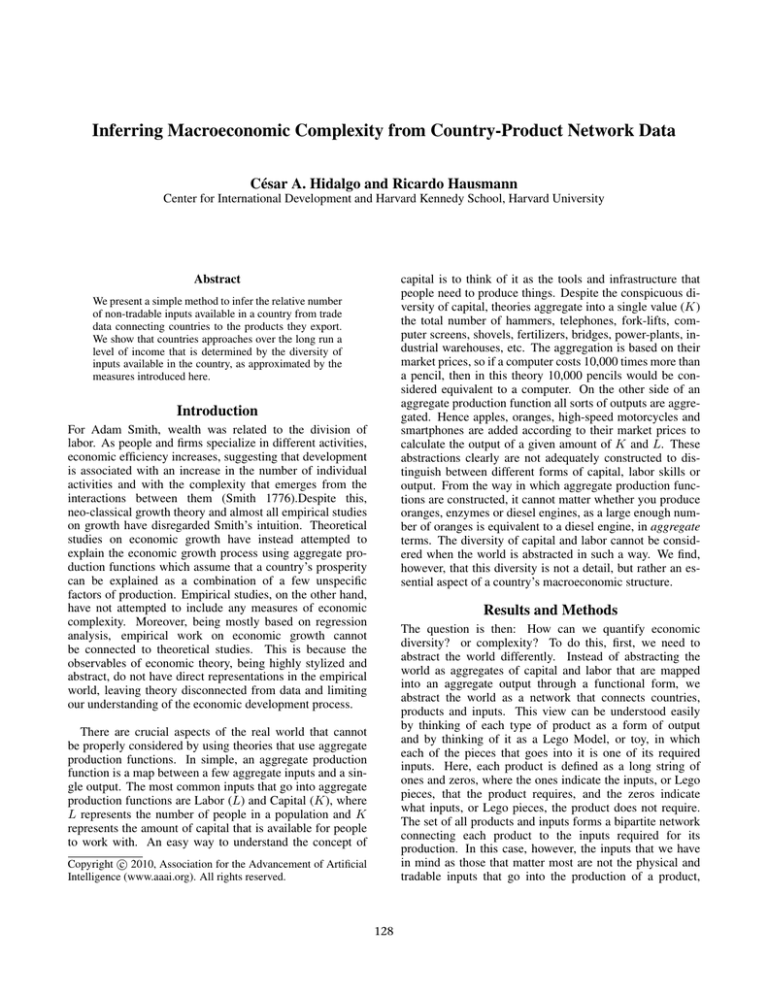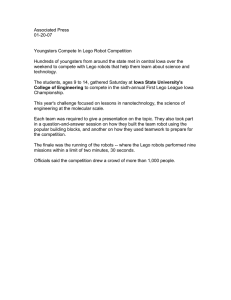
Inferring Macroeconomic Complexity from Country-Product Network Data
César A. Hidalgo and Ricardo Hausmann
Center for International Development and Harvard Kennedy School, Harvard University
capital is to think of it as the tools and infrastructure that
people need to produce things. Despite the conspicuous diversity of capital, theories aggregate into a single value (K)
the total number of hammers, telephones, fork-lifts, computer screens, shovels, fertilizers, bridges, power-plants, industrial warehouses, etc. The aggregation is based on their
market prices, so if a computer costs 10,000 times more than
a pencil, then in this theory 10,000 pencils would be considered equivalent to a computer. On the other side of an
aggregate production function all sorts of outputs are aggregated. Hence apples, oranges, high-speed motorcycles and
smartphones are added according to their market prices to
calculate the output of a given amount of K and L. These
abstractions clearly are not adequately constructed to distinguish between different forms of capital, labor skills or
output. From the way in which aggregate production functions are constructed, it cannot matter whether you produce
oranges, enzymes or diesel engines, as a large enough number of oranges is equivalent to a diesel engine, in aggregate
terms. The diversity of capital and labor cannot be considered when the world is abstracted in such a way. We find,
however, that this diversity is not a detail, but rather an essential aspect of a country’s macroeconomic structure.
Abstract
We present a simple method to infer the relative number
of non-tradable inputs available in a country from trade
data connecting countries to the products they export.
We show that countries approaches over the long run a
level of income that is determined by the diversity of
inputs available in the country, as approximated by the
measures introduced here.
Introduction
For Adam Smith, wealth was related to the division of
labor. As people and firms specialize in different activities,
economic efficiency increases, suggesting that development
is associated with an increase in the number of individual
activities and with the complexity that emerges from the
interactions between them (Smith 1776).Despite this,
neo-classical growth theory and almost all empirical studies
on growth have disregarded Smith’s intuition. Theoretical
studies on economic growth have instead attempted to
explain the economic growth process using aggregate production functions which assume that a country’s prosperity
can be explained as a combination of a few unspecific
factors of production. Empirical studies, on the other hand,
have not attempted to include any measures of economic
complexity. Moreover, being mostly based on regression
analysis, empirical work on economic growth cannot
be connected to theoretical studies. This is because the
observables of economic theory, being highly stylized and
abstract, do not have direct representations in the empirical
world, leaving theory disconnected from data and limiting
our understanding of the economic development process.
Results and Methods
The question is then: How can we quantify economic
diversity? or complexity? To do this, first, we need to
abstract the world differently. Instead of abstracting the
world as aggregates of capital and labor that are mapped
into an aggregate output through a functional form, we
abstract the world as a network that connects countries,
products and inputs. This view can be understood easily
by thinking of each type of product as a form of output
and by thinking of it as a Lego Model, or toy, in which
each of the pieces that goes into it is one of its required
inputs. Here, each product is defined as a long string of
ones and zeros, where the ones indicate the inputs, or Lego
pieces, that the product requires, and the zeros indicate
what inputs, or Lego pieces, the product does not require.
The set of all products and inputs forms a bipartite network
connecting each product to the inputs required for its
production. In this case, however, the inputs that we have
in mind as those that matter most are not the physical and
tradable inputs that go into the production of a product,
There are crucial aspects of the real world that cannot
be properly considered by using theories that use aggregate
production functions. In simple, an aggregate production
function is a map between a few aggregate inputs and a single output. The most common inputs that go into aggregate
production functions are Labor (L) and Capital (K), where
L represents the number of people in a population and K
represents the amount of capital that is available for people
to work with. An easy way to understand the concept of
c 2010, Association for the Advancement of Artificial
Copyright Intelligence (www.aaai.org). All rights reserved.
128
countries have, and what Lego pieces products require, in
principle it should be possible to say something about the
relative number of Lego pieces in a country, or required by a
product, by looking at the network that connect countries to
the products they make. This is because the production of a
product by a country carries information on the Lego pieces
available in that country, and on the Lego pieces required by
that product. Hence, the structure of the bipartite network
connecting countries to products has information on the
structure of the tripartite network connecting countries
to the Lego pieces they have and products to the Lego
pieces they require. Formally, we represent the network
connecting countries to products using the adjacency matrix
Mcp and will show how some of its statistical properties
carry information on the networks connecting countries to
the Lego pieces they have (Cca ) and products to the Lego
pieces they require (Ppa ).
but rather the variety of non-tradable, or hardly tradable
inputs that need to be available to produce that good. The
Lego analogy is therefore conceptual, rather than direct.
For instance, if the product is apples, in our abstraction of
its production some of the Lego pieces it requires could be
adequate customs, a proper port infrastructure, cold storage
transport services and facilities, phytosanitary regulations,
a climate that is adequate for growing apples and specific
human capital skills such as grafting and expertise in apple
tree biology. Countries, on the other hand, at any point
in time are endowed with a specific set of Lego pieces
which determines the mix of products they can make, as
countries can only make products for which they have all
the necessary pieces available.
While in practice, we do not know what Lego pieces
We observe Mcp empirically using trade data compiled
by Feenstra et al. connecting 132 countries to 1006 product
categories disaggregated according to the SITC-4 rev2
classification (Feenstra et al 2005). We consider a country
as the exporter of a product if its Revealed Comparative
Advantage (R) (Balassa 1986) is larger or equal than 1.
The Revealed Comparative Advantage that a country has
on a product is defined as the ratio between: (i) the share
of the market of a country that a product has and (ii) the
share of the world market that a product represents. For
instance, in the year 2000, copper represented 26% of
Chile’s exports, but accounted for 0.2% of total world trade.
Hence, Chile had an RCA on copper for the year 2000
of R=26/0.2=130, indicating that Chile is an extremely
competitive copper exporter. In general, it is customary
to say that country c has RCA in product p if Rcp ≥ 1.
By definition if a country does not export a product it
will have no revealed comparative advantage in it (R=0).
RCA is a measure of the importance of a product in a
country’s export basket that controls for both the size of
the country’s economy and the size of the products market.
This simplification allows us to define Mcp a simple
graph that connects countries to the products they export
if the RCA of a country in a product is larger or equal than 1.
Inferring the relative number of Lego pieces in a country
can be done relatively simply if we assume that countries
can only do products if they have all the Lego pieces that
those products require. In such a case, the diversification, or
number of products that a country makes, will be related to
the number od Lego pieces that that country has available.
This is because countries that have a larger variety of Lego
pieces will have, even by chance, the combinations required
to produce a larger variety of products than countries with
few Lego pieces. From a network perspective the diversification of a country can be calculated simply as the degree, or
number of links, that that country has in the country-product
network. We denote the degree, or diversification, of a country in the country product network as kc,0 , which can be cal-
Figure 1: a-c, GDP as a function of our first three measures
of diversification (kc,0 , kc,2 , kc,4 ), normalized by subtracting their respective means (kc,N ) and dividing them by
their standard deviations (stdev(kc,N )). a, kc,0 , b, kc,2 . c,
kc,4 . d, Absolute value of the Pearson correlation between
the log(GDP) of countries and its local network structure
characterized by kc,N . (Figure from Hidalgo and Hausmann
2009)
129
number of Lego pieces available in a country, or required by
a product, that have complementary biases and can be used
to create estimates of the relative number of Lego pieces
available in a country and required by products by iteratively correcting for one another. This is the idea behind the
Method of Reflections (Hidalgo and Hausmann 2009) which
results in a family of variables that can be used to estimate
the complexity of countries’ productive structures and the
sophistication of products. The variables are given by:
1 kc,N =
Mcp kp,N −1 ,
(3)
kc,0 p
kp,N =
Figure 2: Growth in GDP observed between 1985-2005 as a
function of growth predicted from kc,18 and kc,19 measured
in 1985 and controlling for GDP in 1985. (Figure from Hidalgo and Hausmann 2009)
culated as:
kc,0 =
Mcp .
1 kp,0
Mcp kc,N −1 ,
(4)
c
The variables produced by the method of reflections can be
seen as estimators of the number of Lego pieces available in
a country and required by products and will be used in the
rest of the paper as indicators of the complexity of country’s
productive structure and product sophistication. As we
increase N , the values taken by these variables converge to
the mean, so we need to worry only about the relative values
of these variables, rather than their absolute magnitudes.
(1)
p
Diversification is related to the number of Lego pieces
available in a country, albeit imperfectly. This is because
countries producing the same number of products could
be making goods that require different numbers of Lego
pieces. In such cases, the diversification of countries would
not be the most accurate estimator of the number of Lego
pieces available in those countries, and we would need a
measure of the number of Lego pieces required by a product
to correct for this.
Economic Complexity Income and Growth
To better understand the value of the macroeconomic
complexity measures developed above we compare it with
the GDP per capita of countries adjusted by purchasing
power parity (G), which is a well established measure of
a country’s level of economic development. When doing
this we find that Pearson’s correlation between G and kc,n
grows as a function of n (Figure 1), indicating that there
is a relationship between a country’s level of income and
the number of Lego Pieces we infer that country to have.
More interestingly, however, is the fact that the residual of
this relationship predicts economic growth (Figure 2). This
suggest that countries tend to approach a level of income
which is determined by the complexity of their economies.
Using the symmetry of the bipartite network we can estimate the number of capabilities required by a product by
looking at that product’s ubiquity, which is given by the
number of countries that produce a product and can be calculated as:
kp,0 =
Mcp .
(2)
c
The ubiquity of a product will be related to the number
of Lego pieces that product requires because products that
require few Lego pieces will be more likely to be produced
in many countries. This is because countries with both,
many and few Lego pieces, will have the necessary mix
required by products needing only a small number of
Lego pieces. Therefore, we can improve our estimate of
the number of Lego pieces available in a country, or of
the complexity of its economy, by looking at the average
ubiquity of the products that a country exports.
Conclusion
By abstracting the economy using Networks, instead of
aggregate production functions, it is possible to quantify the
diversity of economic inputs. This allows us to differentiate
easily between countries that, while having the same
aggregate amount of capital, have their capital endowment
structured differently. This distinction allowed us to show
that the diversity of capital, or more generally, the diversity
in the different number of inputs available in a country
determines the ability of countries to generate income and
prosperity.
Yet, the ubiquity of a product is also an imperfect measure of the number of Lego pieces it requires and it needs
to be corrected by a measure of the number of Lego pieces
available in the countries producing that product. From the
above we know that we can approximate the number of Lego
pieces in a country by that country’s level of diversification.
Hence, diversification and ubiquity are both measures of the
The diversity of capital implies that coordination problems should be among the most common obstacles of
economic development. This is because when diversity is
taken into account it becomes clear that economic growth is
not about accumulating more capital, but it is rather about
130
accumulating complementary forms of capital. The returns
to each one of this specific forms of capital, or Lego pieces,
however, depends on the existence of other pieces. This
lies at the root of the coordination problems that policy
makers and entrepreneurs face when trying to develop a
new industrial sector. Countries partially overcome this
coordination problems by moving towards products that
require a similar set of Lego pieces than those required
by the products they are currently producing. This defines
a network of relatedness of products, or Product Space
(Hidalgo et al 2007) that can be approximated by projecting
the country-network into the space of products. Ultimately,
the Product Space can be used to help guide industrial
policy and development in places where the few options
available can be hard to find, if any.
References
Smith, A. 1776 The Wealth of Nations
Feenstra, R.C.; Lipsey, R.E.; Deng, H.; Ma, A.C.; Ma, H.
2005 NBER Working Paper 11040.
Balassa, B. 1986. Comparative advantage in manufactured
goods: A reappraisal. Rev. Econ. Stat. 68:315.
Hidalgo, C.A.; Hausmann, R. 2009. The building blocks
of economic complexity. Proc. Natl. Acad. Sci.
106(26):10570-10575.
Hidalgo, C.A.; Klinger, B.; Barabási, A.-L.; Hausmann, R.
2007. The product space conditions the development of
nations. Science 317:482-487.
131







